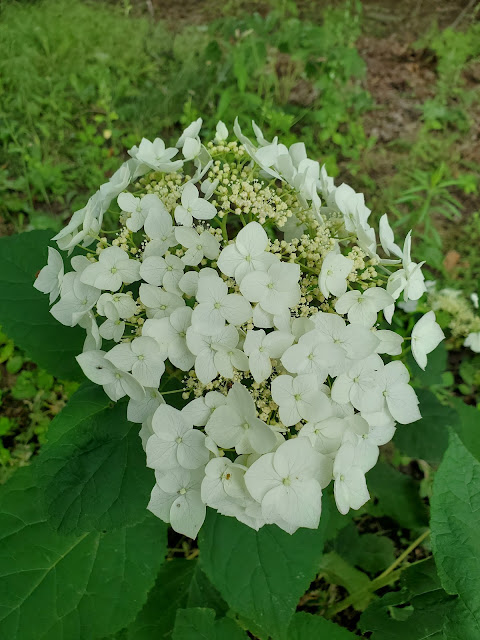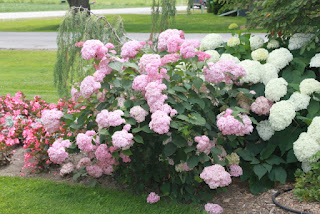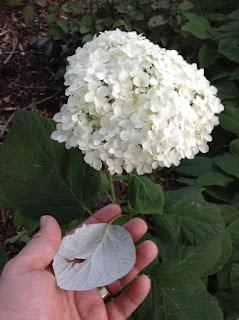Mt. Cuba Center recently released the results from their Hydrangea arborescens (and relatives) trial, and I want to offer some of my views on their results. For those unfamiliar with them, they're in Delaware and their trails are excellent for recommendations of what performs well in the mid-Atlantic region.
I'm a fan of H. arborescens, it's a reliable performer for gardeners throughout much of the country. For us here in the upper mid-west, it's hardy, blooms well, and grows beautifully in bright shade to a fair bit of sun. It also happens to be soil adaptable and generally attractive to a range of pollinators including flies, bees, and wasps. Butterflies and hummingbirds aren't terribly common visitors, but they do occasionally utilize Hydrangea.
The first thing I want to say is that I'm mostly unsurprised by the results. The top ten are varieties known to be excellent performers and maybe the only one that surprises me is the old 'Grandiflora'. Which brings me to another surprise; 'Annabelle' received a 4.0 rating, which is higher than several newer varieties that I would rate higher than due to better habit.

'Haas Halo' took the spot of top performer with a 5 star rating. We've been selling this one for a few years now and my plant was recently planted and isn't mature but I'm already happy with its performance. Foliage is dark green, the lacecap flowers are large have a good balance of sterile and fertile flowers, and it's fairly attractive to pollinators. For Mt. Cuba this one reached 7' tall and wide; here in the far north I expect this one to be a bit more reasonably sized, but time will tell. Cutting it back in spring can bring the height to 4' or so and the flowers will be even larger. This is the standard by which all lacecap H. arborescens should be judged.
I don't have a photo, but ‘SMNHALR’ LIME RICKEY® PP28858 took second place with a rating of 4.6. This variety has relatively flat mophead clusters that are smaller than 'Annabelle', which leads to the overall habit being sturdy and upright. It was one of the largest plants in their trial, reaching almost 6'x8' and I'd expect it to be slightly smaller here in the far north. Sterile flowers start out lime green, mature to creamy white, and age back to lime green. Fertile flowers are pink. This is a hybrid of H. radiata x H. arborescens 'Pink Pincushion' and was bred by Spring Meadow Nursery and introduced as part of the Proven Winners® line of plants; unfortunately it has already been discontinued and is no longer available. If you see it for sale, it's worth picking up if you're looking for a reliable mophead.
I also don't have a photo of ‘NCHA4’ INCREDIBALL BLUSH® PP28280, which came in with a rating of 4.5. This is tied for the top rated pink variety in the trial with the next variety; and the flowers are large, medium-pink maturing to blush pink, mopheads on sturdy stems to 4' tall. Foliage is dark green and overall habit was 5' wide. It grew best in full sun and they found that cutting it back in spring led to larger flowers but weaker stems, so don't cut it back.

Tied for third place was ‘NCHA2’ INVINCIBELLE SPIRIT II® PP28316 with a rating of 4.5 as well. Like INCREDIBALL BLUSH® this was bred by Tom Ranney at NCSU and has a similar genetic background. Flowers are darker pink and slightly smaller. Habit was sturdy and upright. Of all the mopheads, this variety was the most attractive to pollinators. It scored much better than its predecessor, ‘NCHA1’ INCINCIBELLE SPIRIT® (pictured below in several gardens) for having a more robust habit and darker pink flower color (along with more pollinator visits).



So far, my experience has not been the same. INVINCIBELLE SPIRIT® has been more sturdy and flower color has been a cleaner, clearer pink. It is however several years older and maybe gets slightly more sunlight, so I'm not judging INCINCIBELLE SPIRIT II® too harshly yet. For the record, INVINCIBELLE SPIRIT® scored 3.7, lower than 'Annabelle' which is a huge surprise to me and I strongly disagree with this rating. But it's kind of irrelevant since it's not available any more.

Third place was a three-way tie and the third of these plants was, unsurprisingly, ‘Abetwo’ INCREDIBALL® PP20571. Foliage is medium green, stems are sturdy, mophead flowers are large and start lime-green maturing to white, and habit is 5.5'x7.5'. This plant is an improvement over its parent, 'Annabelle', in every possible way and it baffles me that some nurseries are still growing that and not this. The above picture was taken at Rotary Botanic Garden in Janesville, WI post-bloom and the flowers were still held nicely upright.
That rounds out the top 3 plants, from here I'm going to talk only about plants I've grown or observed. In fifth place was ‘Dardom’ White Dome® PP14168. I don't have any pictures, I grew and sold this commercially for a bunch of years and it was always a tough sell. I think partly because it's a lacecap, which are never as popular as mopheads, but also because it is an incredibly vigorous variety and never looked great in pots! But if you can find this one for sale and want a lacecap it's not a bad inclusion for the garden. Plants are robust, stems are sturdy, flowers are large and extremely attractive to pollinators, and foliage is dark green.

‘NCHA3’ INVINCIBELLE RUBY® scored 4.0. I've only seen this one in pots at retail, but I'd like to get one in the garden. Flower color was a nice dark pink, similar in color to BELLA ANNA but larger in all ways. Foliage was dark. For Mt. Cuba this variety was only 2.5'x4' which seems excessively small to me; I'd expect it to grow larger. It performed best in full sun for them, so plant in a bright location. They had trouble with broken flower stems, but cutting back in spring alleviated this issue.
 |
| Ruby-throated hummingbird on 'Annabelle' |
'Annabelle' is the most popular H. arborescens on the market. I may be overly harsh on it, but when I encounter it, it's floppy and weak-stemmed more often than not. It scored 4.0, which is higher than I'd rate it; I'd probably move it down to a 3.5. These days there are any number of better varieties.
‘PIIHA-1’ ENDLESS SUMMER® BELLA ANNA PP21227 was such a promising plant when it was released. Unfortunately it failed to deliver on that promise and ranked 3.5. Flowers start out green and gain pink tones. Overall effect is green, turning mahogany, then pink; it's an effect that I quite like, but not everyone appreciates brown flowers. Stems are very weak and brittle, leading to floppy flower stems laying on the ground. Foliage is yellow-green to medium green and fairly small. I still have one for posterity, but maybe I'll ditch it some day.
Ranking even lower are some varieties that I grow here and have sold, would sell, or will sell.
The first of them is 'Hayes Starburst', known for its double flowers. Unfortunately it's also known to be quite floppy and totally sterile, making it unattractive to pollinators. These two characteristics gave it a 3.2 rating. We did have a few to sell last year as some people (like me) still want this for its flower effect. We may occasionally offer it with the caveat that it's not sturdy.


One of the most unique Hydrangeas on the market has 3 different names, but they're all the same plant: 'Green Dragon', 'Riven Lace', or 'Emerald Lace'. Being that I'm a fan of fantasy fiction and RPG games, I prefer 'Green Dragon' personally. This scored a low 3.1. it was unattractive to pollinators and they experienced leaf burn even in the shade. Here in the north, leaf burn isn't an issue and I would score it higher. Due to the uniquely twisted and serrate foliage, this is worth growing for its ornamental characteristics, but should be avoided if pollinators are your focus. I'll keep an eye on mine for pollinator attraction here, maybe it's a regional preference. I'm interested to see if pollinator friendliness can be bred into it, but I don't know if I have time for that project. This is one that I will absolutely offer for sale in the future.

H. radiata 'Samantha' scored a low 3.1. The species shows drought stress readily (which matches my experience) and in sun the sterile flowers of this mophead variety quickly turned brown. Even in shade the flowers aren't as long lasting. The foliage tends to be medium to dark green and the leaf backs are beautifully white. I find the stems fairly sturdy. Given my northern location, I would rate this a bit higher as the flowers don't brown out so badly in shade here but are still short-lived. The straight species, H. radiata, with its lacecap flowers scored the lowest at 2.5 which I can't say I agree with. It's been somewhat slow growing here and exhibits the short-lived flower problems above, but it does tend to have a nice habit when I've seen it. Pollinators were fairly attracted to this species as well. But, other than the silver leaf backs there are many varieties far superior to either of these forms. I do look forward to seeing white leaf backs on modern hybrids with good performance some day, but until then we may occasionally offer either of these as a horticultural curiosity. The leaves turn and flip in the wind and the effect of flashing white backs is compelling, if nothing else.
So overall, based on the above results, look for 'Haas Halo' (we sell it!), INCREDIBALL BLUSH®, INVINCIBELLE SPIRIT II®, or INCREDIBALL® as the current best options. There are other good options out there as well and a few that are at least interesting enough to include if you have the space or desire for something different. More varieties have been introduced and aren't included in this trial, so it will be neat to see how they compare.















No comments:
Post a Comment
Note: Only a member of this blog may post a comment.